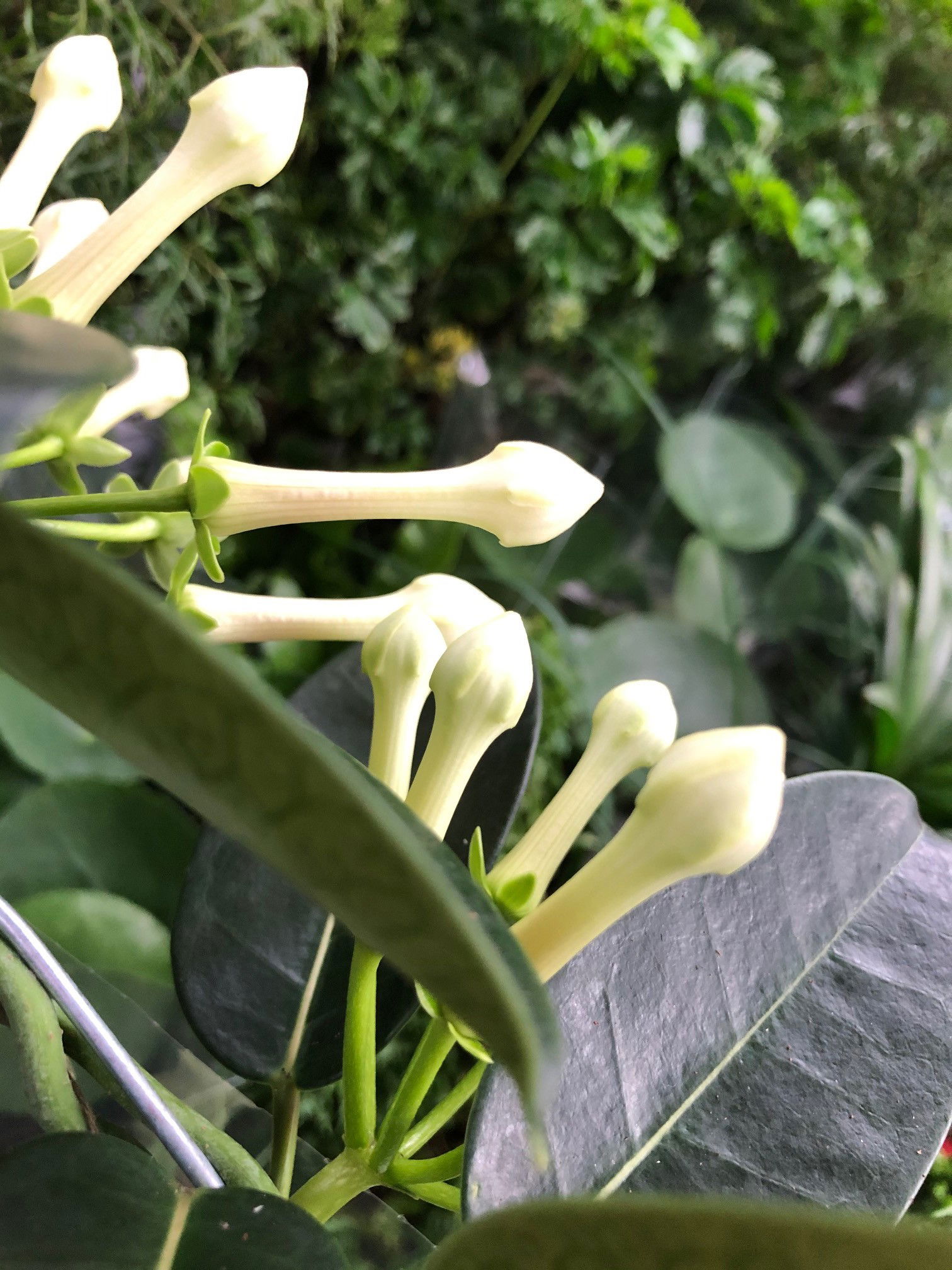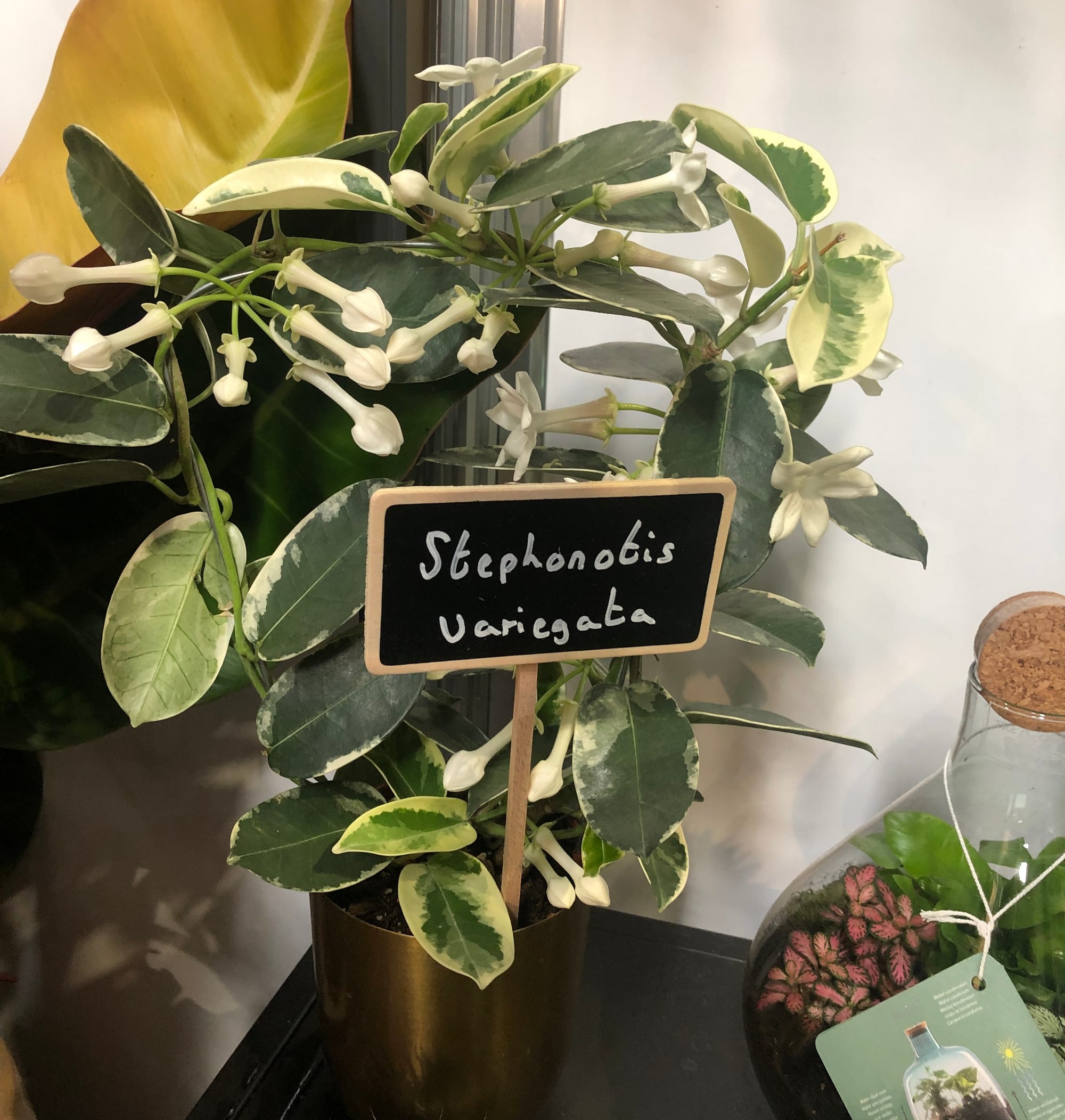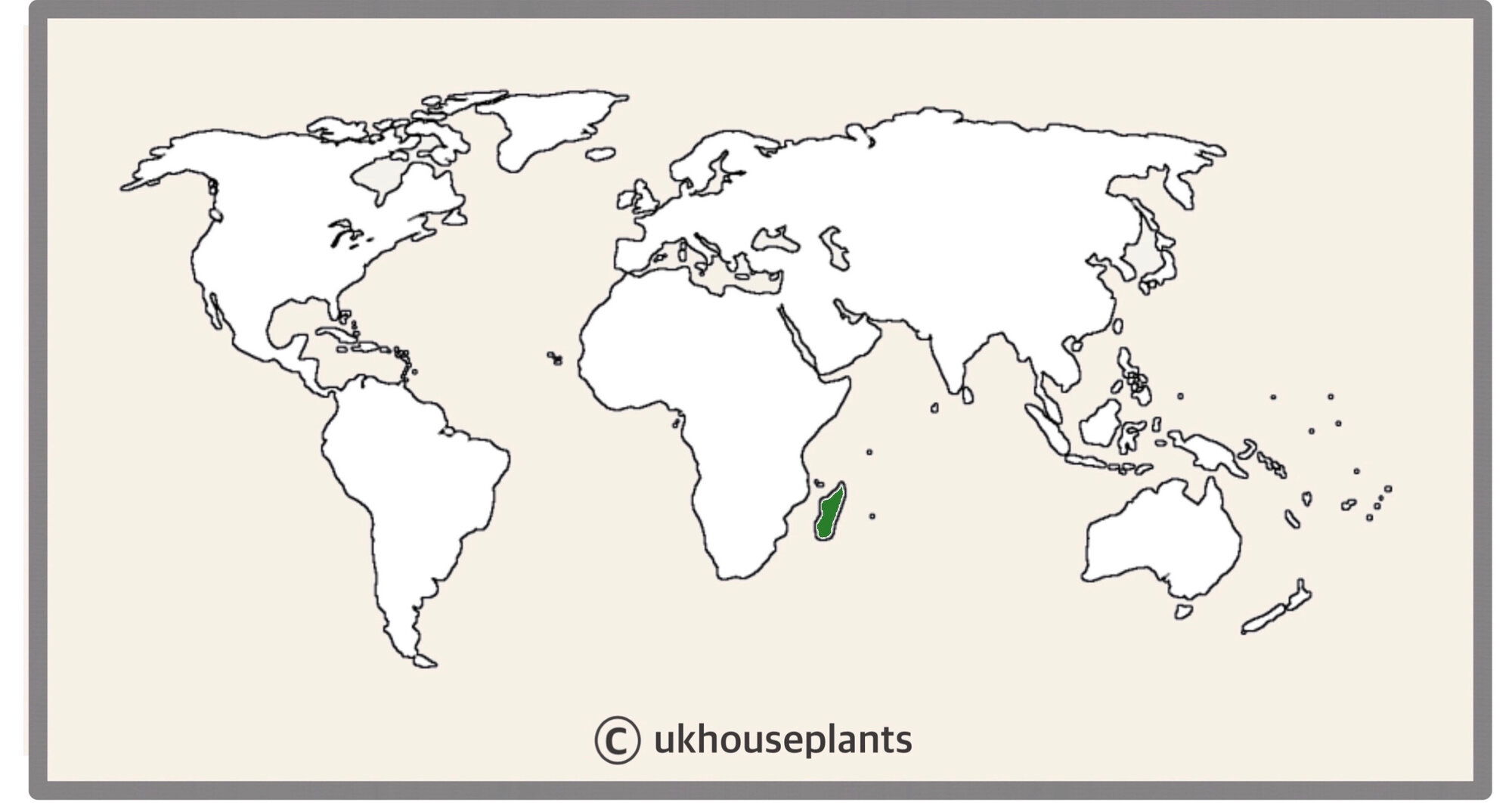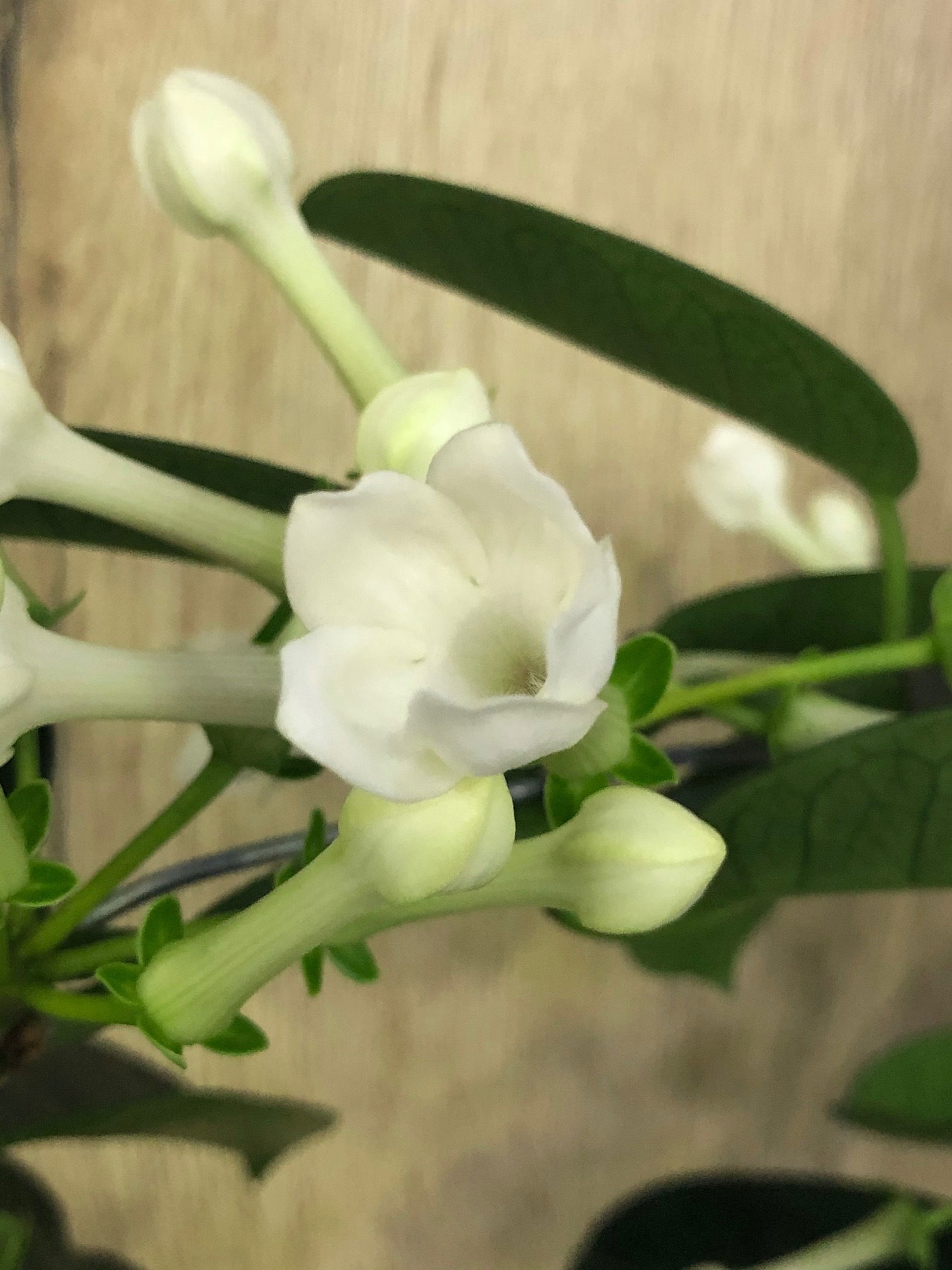
Stephanotis floribunda
Contents
- Top Tips
- Location, Water, Humidity & Fertilisation
- Dormancy Care & Annual Flowers
- Common Issues
- Origins, Temperature, Propagation, Repotting & Toxicity.
Need the answer to a specific plant query? Book a 1-to-1 video call with Joe Bagley, the website's friendly author to overcome and address your niggling problem! Available on iMessage, WhatsApp, Facebook Messenger & more.
Top Tips & Info
- Care Difficulty - Moderate
- During the spring and summer, provide a bright location with no direct sunlight. We'd recommend a north-facing window or within two metres of any other facing window during this time. From late autumn onwards, be sure to provide an hour or two of morning sunlight to get it through the dormancy period.
- Keep the soil evenly moist, allowing the top third to dry out in between irrigations. Avoid prolonged droughts or the use of cold water whilst the plant is in bloom.
- Fertilise using a 'Houseplant' labelled fertiliser every two to four weeks, depending on the season.
- Repot your Stephanotis every three years using the next sized pot with adequate drainage. We'd recommend using a 'Houseplant' labelled potting mix, which will include a healthy balance of organic matter and perlite.
- Scroll down to 'Dormancy Care & Annual Flowers' to learn more about achieving a spring show of blooms.
Location & Light - 🔸🔸🔸
Avoid direct sunlight in the spring and summer months, providing a splash of direct sun in the autumn and winter. A dark location that offers no sufficient light must be avoided - if you can't read a newspaper without artificial lighting, it'll be too dark for a Stephanotis, also.
Place your specimen on, or within two metres of a north-facing window if you tend to under-water plants. A metre away from an east or west-facing windowsill is the ideal location for good quality growth over the year. During the winter, provide a cool (12°C, 54°F) and bright area, possibly with a splash on sunlight to improve the quality of its dormancy period.
Water - 🔸🔸
During the spring and summer months, allow a third of the soil to dry out in between irrigations, reducing this slightly further in autumn and winter. If it's in bloom, avoid using cold water due to their sensitivity to temperature change that can result in flower loss and slowed growth. Under-watering symptoms include stunted growth, flower loss, wilting, crispy brown patches developing on its leaves, and gradual decline. These issues are usually down to too much sunlight or heat, a much-needed repot or forgetfulness. Over-watering symptoms include lower yellowing leaves, stunted growth, wilting or brown spots with yellowed halos on its leaves. These issues are usually familiar with either too little light/heat or overly soggy soil in between waters. Browning legions with yellow halos on its foliage are a common issue among indoor gardeners, predominantly caused by anaerobic soil from over-watering. As you water the potting mix, the oxygen will rise to the surface (much similar to oceanic bubbles) that'll starve the roots until they being to rot. Scroll down to 'Common Issues' for more information.
Humidity - 🔸🔸
Create a humidity tray to provide a moist and stable environment for your plant. If the surrounding saturation is too low or the heat too high, its leaf-tips may start to brown over and curl, especially in direct sunlight. Gently hose the foliage down from time to time to hydrate the leaves and keep the dust levels down.
Fertilisation - 🔸🔸
Fertilise your plant every two weeks in the spring and summer, reducing this to monthly for the colder months of the years. Although we'd recommend using a 'Houseplant' labelled feed throughout the year, you can swap this for a potassium-based product like 'Tomato' food to help the longevity of its flowers. Avoid directly applying 'ready-to-pour' fertilisers into the soil without a pre-water due to the roots' sensitive nature to harsh chemicals.
Dormancy Care & Annual Flowers
Provide a bright, and cool autumn and winter period around 15℃ (59℉) to reinforce its dormancy. Keep the roots pot-bound to add further stress onto the specimen, which in turn will heighten the chance of flowering. Blooms will generally appear in the spring and summer months, during active growth.
The following steps should be taken from early autumn until the end of winter.
Sunlight & Location
Be sure to provide a bright location with no direct sunlight; those kept on a north, east or west-facing window is most happy. Avoid deep shade and the use of artificial lighting at night or locations that boast temperatures higher than 18℃ (64℉).
Hydration
Reduce waters so that at least half of the soil becomes dry. It's essential to keep them on the drier side to life, as they'll think that hard times are ahead and therefore will need to pass its genes on to the next generation.
Occasional Feeds
During the autumn and winter, fertilisation should be performed at monthly intervals with a 'Houseplant' or 'Streptocarpus' labelled feed. While the flowers are budding or in bloom, use a Tomato fertiliser to provide fortnightly nourishment of potassium.
Reduce Everything
This is to remind you that everything needs to be reduced - especially the temperature.
Temperature
This is the most significant step; reduce the temperature down by around 5℃ compared to the summertime or place in a room that's between 14º - 17℃ (57º - 62℉). You'll be at a significant disadvantage if the ambient temperature is kept constant throughout the year, as Gerbera will only respond in locations that have daily fluctuations of around 5℃. Never exceed the minimum temperature as it may lead to plant death or yellowed foliage at a bare minimum. If these steps are followed successfully, you could see a show of blooms in the following summer - but remember, dealing with nature may not always provide the results you'd relish.
Common Issues with Stephanotis
Root rot is a common issue among specimens sat in too dark environments with prolonged soil moisture. Symptoms include rapidly yellowing leaves, mouldy soil, stunted growth and a rotten brown base. Take the plant out of the pot and inspect health below the compost line. If the roots sport a yellow tinge, you're good to go, but those that are brown and mushy must be addressed immediately. More information about managing root rot can be found on this link.
Yellowing lower leaves (closest to soil) could be a sign of over-watering, but equally is a byproduct of maturity. If the older leaves rapidly become yellow in quick succession, over-watering could be to blame. People don't realise that a plant's root system needs access to oxygen too; when soil is watered, the air will travel upwards and out of the potting mix. A lack of accessible oxygen for the roots will cause them to subsequently breakdown over the oncoming days. Click on this link to learn more about root rot and how to address it.
Too much sunlight will lead to sun scorch, with typical signs including browning or crispy leaves, dry leaf-edges, sunken leaves or stunted growth. Although too little light will cause over-watering issues, excess sunlight will be a detriment to the plant as well. If yours has fallen short of this, reduce the amount of the sun considerably and always be mindful of environmental shock (when two locations offer too different growing conditions). Remove some of the affected leaves and increase waters slightly.
 Variegated varieties are more likely to suffer from low light-related issues than fully-green specimens. If you have a variegated Stephanotis, ensure it grows in either a north, east or west-facing windowsill (away from an operating radiator though) or under a grow light to collect the light energy it needs to remain healthy.
Variegated varieties are more likely to suffer from low light-related issues than fully-green specimens. If you have a variegated Stephanotis, ensure it grows in either a north, east or west-facing windowsill (away from an operating radiator though) or under a grow light to collect the light energy it needs to remain healthy.
Pests could arise at any time, with infestations starting from the original nursery or via contamination in your home. Spider Mites and Mealybugs to tend to be the usual inhabitants, with the first being minute and almost transparent, roaming the leaves in search of chlorophyll and a site to hide its eggs. The latter, however, will stand out much more, with white cottony webs developing across the foliage and stems. Thoroughly check the plant's cubbyholes before giving it the all-clear, or click on the appropriate links to learn more about eradicating these issues!
Clean the leaves regularly. Although this isn't too much of an issue, a build-up of dust particles can clog up the plant's pores, causing lowered light capturing-efficiency. Rinse the topsides of the leaves down once a month to keep levels down and improve growing conditions.
A lack of flowers is caused by an insufficient dormancy period, where the temperatures are kept more or less the same over the year. Reduce the temperature by a couple of degrees over the autumn and winter months, along with fewer irrigations to ensure a well-spent dormancy. As spring arrives, the natural temperature will begin to increase, with this is being the perfect time to increase waters and fertilisation. Remember, the warmer the summer days are, the more likely a specimen is to reflower.
A sudden loss of older flowers with a yellowed stalk is a sign of prolonged droughts. Especially during the flowering process, near-continuous moist soil is mandatory for extended blooms; allow the roots to turn a green-greyish colour in between irrigations.
Origins
Stephanotis was first described back in 1806 by Frenchman, Louis-Marie du Petit-Thouars, who brought live specimens back to France shortly after. The name, Stephanotis, comes from the Greek phrase for 'fit for a crown', which refers to the flower shape and ability to intertwine around a circular trellis.
 The Distribution of Stephanotis
The Distribution of Stephanotis
Temperature
10° - 25°C (50° - 78°F)
H1b (Hardiness Zone 12) - Can be grown outdoors during the summer in a sheltered location with temperatures above 12℃ (54℉), but is fine to remain indoors, too. If you decide to bring this plant outdoors, don't allow it to endure any direct sunlight as it may result in sun-scorch and dehydration. Regularly keep an eye out for pests, especially when re-introducing it back indoors.
Stephanotis thrive in warm, humid locations and generally will flower much better if a good dormancy is served in the winter when the temperature dip to 12°C (54°F).
Spread
Up to 2m in height and width, when trained up a trellis or support brackets. The ultimate height will take between 5 - 8 years to achieve.
Pruning & Maintenance
Remove yellowed or dying leaves and plant debris to encourage better growth and improve the all-round appearance. Pruning must be done with clean scissors or shears to reduce the chance of bacterial and fungal diseases; remember to make clean incisions as too much damage can shock the plant.
Prune the leading and lateral growths back to the main stem after flowering. Do not prune in the spring due to the heightened chance of removing the buds.
Propagation
Via Seed or Stem Cuttings.
For stem cuttings, use shoots that have a soft, bendy wooded base that haven't flowered. They should be at least 8cm (3 inches) in length and are found in the outer edge of the plant where the new growth takes place. Remove the lower half of the leaves, dip the wound in a rooting hormone and place in a well-draining potting mix - 'Houseplant' Compost is advised. Keep the cuttings in a transparent bag to maintain high humidity. While the plantlet is still young, avoid direct sunlight and water-logging and repot as necessary, once there is substantial foliar growth. This method can be quite tricky, so be sure to take a few cuttings with different variables to see which suits your skills the best.
N. B. - Air-layered cuttings can be taken during this period, by placing the 8cm stems in a transparent bag with several small holes to maintain high humidity. Do not offer direct sunlight or allow the temperatures to dip below 15°C (59°F).
Flowers
Stephanotis will flower between the spring and summer if served with a good dormancy the winter months. Each individual flower will last up to ten days, with the overall show lasting up to six weeks. Supplement the plant using a feed high in potassium to prolong its flowers - 'Streptocarpus' or 'Tomato' labelled fertilisers are an excellent choice.
 Once opened, a Stephanotis flower can last up to ten days in full bloom.
Once opened, a Stephanotis flower can last up to ten days in full bloom.
Repotting
Repot every three years in spring using a 'Houseplant' labelled potting mix and the next sized pot with adequate drainage. Stephanotis are far better potbound for several years due to the heightened risk of root rot and repotting-issues (like transplant shock), so only repot if you feel it's wholly necessary - restricted root growth will also increase the chance of blooms, too.
Hydrate the plant 24hrs before the tinkering with the roots to prevent the risk of transplant shock. For those situated in a darker location, introduce an extra amount of perlite and grit into the deeper portion of the pot to downplay over-watering risks. Click on this link for a detailed step-by-step guide on transplantation, or via this link to learn about repotting with root rot.
Book a 1-to-1 video call with Joe Bagley if you'd like a personal guide to repotting your houseplant. This will include recommending the right branded-compost and pot size, followed by a live video call whilst you transplant the specimen for step-by-step guidance and answer any further questions!
Pests & Diseases
Keep an eye out for mealybugs, aphids, fungus gnats & root mealybugs that'll locate themselves in the cubbyholes and undersides of the leaves, with the exception of the latter in soil. Common diseases associated with Stephanotis are root rot, leaf-spot disease, Botrytis, rust, powdery mildew & southern blight - click here to learn more about these issues.
Toxicity
This plant is classified as poisonous, so if small sections are eaten, vomiting, nausea, and a loss of appetite may occur. Consumption of large quantities must be dealt with quickly; acquire medical assistance for further information.
Retail Locations
Blue Diamond & Online Stores.
Book a 1-to-1 Call with Joe Bagley
If you need further advice with your houseplants, book an advice call with ukhouseplants' friendly and expert writer today! This can be done via a video or audio call on most apps, including Facebook, FaceTime & Skype. A ten-minute call costs £5.99 (US$7), or £15.99 for thirty minutes. You can ask multiple questions, including queries on plants, pests, terrariums, repotting advice and anything in between. Please consider supporting this service to keep ukhouseplants thriving!